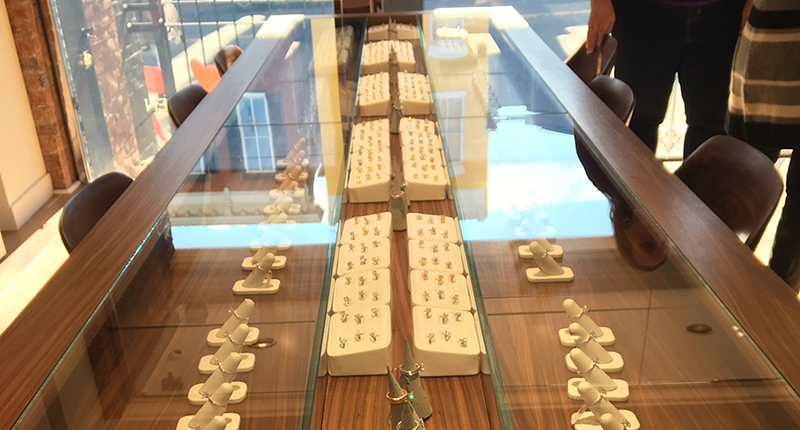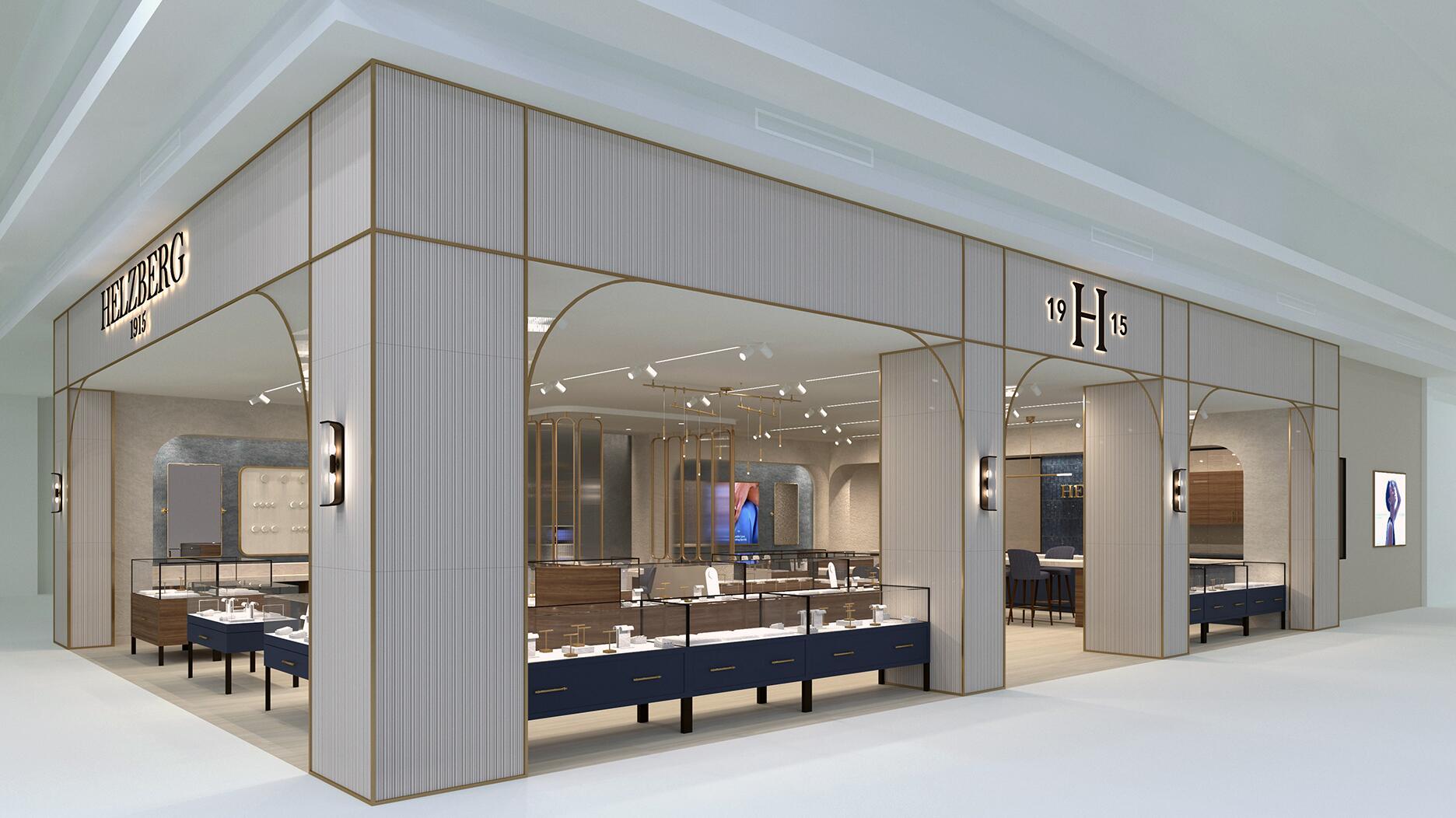The couple pleaded guilty to concealing at least $127 million in cash transactions at its precious metals businesses.
Inside James Allen: 3 Observations About Its First Store
National Jeweler’s editors have spent the past couple weeks visiting pop-ups and secret-shopping online. Now, we’re checking out a new brick-and-mortar concept store.

On Friday, I took Amtrak down to Washington, D.C. to attend the grand opening of the first store for James Allen, the jewelry e-commerce site Signet Jewelers acquired in September 2017.
James Allen certainly isn’t the first once-online-only retailer to decide it needs a physical space where consumers can interact with both the product and its people.
Walk out the front door at James Allen and take a stroll down M Street and you’ll see companies like Warby Parker, the online eyewear seller, and Rent the Runway taking up space.
Warby Parker and RTR undoubtedly opened stores here for the same reason Signet picked this stretch in the capital’s young Georgetown neighborhood: The demographics—largely young and upwardly mobile—are right for retailers that were reverse engineered, so to speak. They established themselves and their customer base online before investing in physical locations.
And when they did invest, they made their stores as much about interaction, education and experience as they did product.
At 1,900 square feet, the James Allen store, which was designed in partnership with JGA, is certainly not huge by U.S. retail standards (but, really, retail spaces don’t need to be anymore).
It also has three characteristics that I think jewelers looking to renovate or open new stores should note.
First, it is light, airy and open.
The entire front of the store is floor-to-ceiling windows. The floors are light-colored hardwood and the display cases and vitrines are sleek, modern and minimal.
There aren’t any dark, clunky display cases or tiny windows crammed with product and I love the choice of hardwood floors over carpeting.
When customers enter the store, they are greeted on the right by a grouping of glass vitrines housing James Allen’s best sellers and trending styles.
I love the idea of showcasing product that’s trending online to in-store customers, and Amazon apparently agrees; the e-commerce giant is experimenting with the idea of stores that sell only top-reviewed products.
But if I were Signet, I would come up with on-brand signage for these best-seller cases, so customers know what they are looking at.
RELATED CONTENT: I’m Your Store’s Online Secret ShopperI would also get something up on the walls, like diamond paintings by Angie Crabtree or Reena Ahluwalia. (Side note: James Allen co-founder and Signet Chief Digital Innovation Adviser Oded Edelman said he already is in talks with Crabtree.)
To the
In the middle of the table, there are CZ and sterling silver engagement ring samples that customers can pick up and try on without assistance. Under the glass, CZs are lined up in order of size so consumers can see, for example, how a 1-carat diamond compares in size to 1 1/2 or 2 carats.

There are a few more trending-product vitrines and cases containing fashion jewelry but that’s basically it, which brings me to my second point about the store: It is not crammed full of showcases that are, in turn, stuffed with jewelry because it is not all about product. It doesn’t have to be.
James Allen engagement rings still will be sold online.
Signet will sell fashion jewelry in the James Allen store because, as CEO Gina Drosos put it, “We want people walking up and down (M Street) with the James Allen bag.”
What Signet also wants is for people to feel comfortable, stay awhile, connect with store employees (who are all employees of the James Allen customer service center in nearby Frederick, Maryland) and create a positive association with the brand.
“This is intended to feel as much like a store as a place to hang out,” Edelman said.
And, like Signet or not, the company’s succeeded in this aspect.
There’s a bar where employees serve free coffee (my review: it’s delish) and sparkling and flat water. Lining the top of the bar are handles of Maker’s Mark.
No, just kidding. There’s no alcohol in the store.
But there are iPads on the bar that allow consumers to play games testing their diamond knowledge, and free Wi-Fi so customers can Google whatever they want while in the store (and, again to Edelman’s point, hopefully stay a while).
Overall, the store is relaxing and sun-filled, there’s good music and the vibe is nice. I didn’t mind sitting down for a while after I finished my interviews and people-watching while my phone charged.
More than creating a hang-out spot that’s like a 2018 version of Central Perk, though, Signet wants to learn from its customers.
The retailer wants to see what they think of all the digital bells and whistles it’s built into this store before it spends money to expand them into thousands of Kay, Jared and Zales locations.
“That’s probably the biggest point of all,” Drosos tells me while giving me the grand tour, pointing out all the technical touches along the way. “This is a digital playground.”
Beyond the table containing the sterling silver and CZ rings, there’s a virtual reality experience that teaches consumers all about the four Cs.
At several places in the store, you’ll find James Allen’s pink abstract heart logo on the floor. Step into it and you’ll hear information about the product in the case in front of you that’s audible only to you.

It’s technology from a company called Holosonics, Drosos tells me, and Signet is testing it out right now.
Then there’s the iPad sitting atop the cases of fashion jewelry armed with technology from a Tel Aviv, Israel-based company called Mystore-E. Drosos said that Signet has invested in the startup (Edelman sits on the board) that is building “intelligent” retail store displays.
Long term, the Mystore-E application that’s in the James Allen store will be able to recognize customers by sight and recommend product when they come in. “Oh, here’s Jen H. She bought a pearl necklace the last time she came in; what about these pearl earrings or bracelet that go with it?”
In the short term, it scans customers’ face, makes determination about their gender and age, and suggests product for them based on that.
RELATED CONTENT: Consumers Saw Lightbox. Here’s What They Wanted to KnowMaybe customers will react favorably to all these innovations, and maybe they won’t. But the point is, having a James Allen store gives Signet the chance to test things before they invest millions of dollars installing them in thousands of stores.
And it gives the retailer to the chance to do so quickly, which brings me to my third point about the store: It is all about speed.
Drosos said technology moves so fast today, retailers need to be able to jump on board with new concepts quickly. Having this singular store that’s focused on technology allows Signet to be more agile.
If something’s hot, Signet can pick it up and test it in the James Allen store. If customers like it, then the retailer will consider a wider rollout. If they don’t, then it’s time to move on.
“It’s the speed of testing and learning that’s so important to us right now,” Drosos said.
The James store is located at 3109 M St. in D.C.’s Georgetown neighborhood. It is open from 10 a.m. to 7 p.m. every day.
The Latest

Consumers shared concerns about prices, inflation, tariffs, trade, and politics in the survey’s write-in response section.

In February 2026, the auction house will move its headquarters to the former Steinway Hall, a neoclassical landmark on Billionaires’ Row.

How Jewelers of America’s 20 Under 40 are leading to ensure a brighter future for the jewelry industry.

The new show will take place Jan. 23-25, 2026.


The former BHP Billiton leader and Gemfields chairman is remembered for his influential leadership throughout his 50-year mining career.

The LVMH-owned brand has partnered with the costume design union to revamp its award for 2026.

Roseco’s 704-page catalog showcases new lab-grown diamonds, findings, tools & more—available in print or interactive digital editions.

The luxury titan inked a deal to acquire an initial minority stake in the jewelry manufacturer with a pathway to full ownership by 2032.

The company’s curation of unsigned vintage and estate jewelry debuted at the Bloomingdale’s in Costa Mesa, California.

In the recent multi-shipment seizure, CBP also found counterfeit Audemars Piguet, Moncler, and Chrome Hearts items.

Jewelers of America execs and National Jeweler editors discuss tariffs, the sky-high gold price, and the engagement that broke the internet.

The luxury goods company said founder Ippolita Rostagno will remain at the brand’s helm.

Laura Burdese, who joined the Italian luxury brand in 2022, will take on the role in July.

Need a gift for the cat lover who has everything? Look no further than our latest Piece of the Week.

It purchased the “Grosse Pièce,” an ultra-complicated Audemars Piguet pocket watch from the ‘20s, for a record-breaking price at Sotheby’s.

The lab-grown diamond grower now offers custom engagement and fashion jewelry through its Kira Custom Lab Jewelry service.

Chandler got his start at Michelson Jewelers and has served as DCA president and CEO since 2001. He will retire at the end of the month.

The boutique is slated to open this week inside Terminal 8, offering pre-owned Rolex watches and more to international travelers.

Sponsored by Digital Monitoring Products

The special-edition egg pendant ingested in a New Zealand jewelry store was recovered after a six-day wait.

Associate Editor Natalie Francisco plays favorites with Piece of the Week, selecting a standout piece of jewelry from each month of 2025.

The “Love and Desire” campaign is inspired by the magic that follows when one’s heart leads the way, said the brand.

Two awardees will receive free tuition for an educational course at the Swiss lab, with flights and lodging included.

Berta de Pablos-Barbier will replace Alexander Lacik at the start of January, two months earlier than expected.

Sotheby’s held its first two jewelry sales at the Breuer building last week, and they totaled nearly $44 million.

Winners will receive free registration and lodging for its fourth annual event in Detroit.


























